Bram Stoker's Dracula Blu-ray Movie
HomeBram Stoker's Dracula Blu-ray Movie 
Sony Pictures | 1992 | 127 min | Rated R | Oct 02, 2007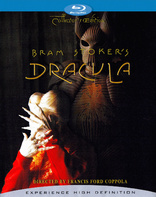
Movie rating
7.7 | / 10 |
Blu-ray rating
| Users | 3.5 | |
| Reviewer | 3.5 | |
| Overall | 3.5 |
Overview
Bram Stoker's Dracula (1992)
A young English lawyer, Jonathan Harker, is sent to a gloomy village in eastern Europe. He is captured and imprisoned by the undead vampire Dracula, who travels to London, inspired by a photograph of Harker's betrothed, Mina Murray. In Britain, Dracula begins a reign of seduction and terror, draining the life from Mina's closest friend, Lucy Westenra. Lucy's friends gather together to try to drive away Dracula and rescue Mina.
Starring: Gary Oldman, Winona Ryder, Anthony Hopkins, Keanu Reeves, Richard E. GrantDirector: Francis Ford Coppola
| Horror | Uncertain |
| Thriller | Uncertain |
| Period | Uncertain |
| Romance | Uncertain |
| Drama | Uncertain |
| Fantasy | Uncertain |
Specifications
Video
Video codec: MPEG-4 AVC
Video resolution: 1080p
Aspect ratio: 1.85:1
Original aspect ratio: 1.85:1
Audio
English: LPCM 5.1 (48kHz, 16-bit)
English: Dolby Digital 5.1 (640 kbps)
French: Dolby Digital 5.1 (640 kbps)
Hungarian: Dolby Digital 5.1 (640 kbps)
Czech: Dolby Digital 5.1
Polish: Dolby Digital 5.1 (640 kbps)
Russian: Dolby Digital 4.0
Subtitles
English, English SDH, French, Portuguese, Spanish, Arabic, Bulgarian, Cantonese, Czech, Danish, Dutch, Finnish, Greek, Hebrew, Hindi, Hungarian, Icelandic, Korean, Norwegian, Polish, Romanian, Swedish, Thai, Turkish
Discs
50GB Blu-ray Disc
Single disc (1 BD)
Packaging
Slipcover in original pressing
Playback
Region free
Review
Rating summary
| Movie | 5.0 | |
| Video | 3.0 | |
| Audio | 4.0 | |
| Extras | 3.0 | |
| Overall | 3.5 |
Bram Stoker's Dracula Blu-ray Movie Review
Reviewed by Martin Liebman October 2, 2015Cinema's longstanding love affair with the vampire seems as storied as any other, and as varied, too. The undead, creature of the night, bloodsucking subject has seen its share of classic, comedy, exploitative, reimagined, and trendy films over the decades, most all of them with some merit but few -- outside of those classics -- holding much real, meaningful value as cinema's most impressively artistic, emotionally satisfying, deeply meaningful, and profoundly thoughtful Vampire film, legendary Filmmaker Francis Ford Coppola's (the Godfather trilogy, Apocalypse Now) Bram Stoker's Dracula. A film that combines graceful moviemaking with a dark undercurrent, a story that blends deep romanticism with the superficial sins of the flesh, a picture that meshes intimate character study with bloody horrors, the film is a bonafide classic of the medium, one of the quintessential definitions of cinema as art and an enduring masterpiece that's nearly as wonderful as the novel on which it's based.
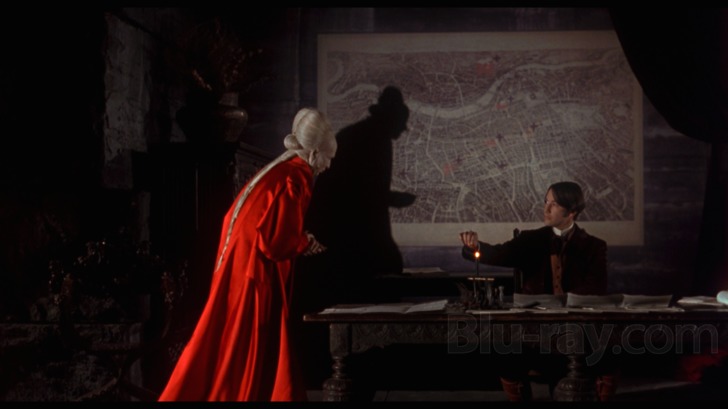
The costumes are the sets, the shadows speak volumes, the movie dazzles as a perfect example of cinema as art.
Young Solicitor Jonathan Harker (Keanu Reeves) travels from London to Transylvania to facilitate a deal for an enigmatic Count, Dracula (Gary Oldman), who is purchasing land in London, including Carfax Abbey. Harker, who is replacing his predecessor R. M. Renfield (Tom Waits) who is wasting away in a London insane asylum, knows not that his visit will forever shape the destinies of all around him. He's set to be married to Mina (Winona Ryder), a London socialite whom Dracula learns bears a striking resemblance to his centuries-dead bride Elisabeta, who committed suicide when she feared Dracula dead in battle. Following her death, Dracula renounced God and vowed to avenge her, and his time, it seems, has arrived. After closing the deal, Dracula leaves Harker imprisoned in his castle while he travels to London to meet Mina. He attacks and infects Mina's friend Lucy (Sadie Frost). Her suitors -- Dr. Jack Seward (Richard E. Grant), Quincey Morris (Billy Campbell), and Arthur Holmwood (Cary Elwes) -- hire the vampire hunter Abraham Van Helsing (Anthony Hopkins) to destroy the creature that turned Lucy and threatens Mina.
Bram Stoker's Dracula is essentially a love story and a revenge story, the tale of a man whose life is ravaged by the untimely death of his bride and his vengeful retribution against the light, or perhaps better said "goodness" and "innocence." The story intertwines a rebuke of faith with a craving for flesh and blood, but the film isn't so much concerned with those violent ends but rather why, and the means by which, the Dracula character reaches towards them. The narrative deals in a classic clash between good and evil, with the former in some ways flawed but the latter molded by the world's metaphorical darkness and an almost understandable, in some perverse way even sympathetic turn to that darkness when righteousness is repaid with torment. Dracula's pledge to renounce God, avenge his bride's death, and turn to evil is a classic motif that is here presented within the fearful prism of vampirism and the grisly, gritty world in which it exists.
Of course, that narrative -- simple in purpose, complex in execution -- is supported by a beautifully haunting production design. The film's story satisfies, but its support pieces are the unequivocal highlight and more than anything -- story, performances -- define the film. Coppola's ability to make such remarkable use of light and shadow not only as atmospheric support elements but as integral foreboding and foretelling elements immediately portends greatness for the film, and the steady manipulation of light and dark to the story's benefit is astounding as a necessary storytelling detail but also when considering the pure artistic merit it demonstrates. The supportive production design pieces -- particularly the film's costuming and its contrast against the sets -- are equally precise, both visually intoxicating and thematically essential. Victorian era London is positively sumptuous, but it's the dreary, shadowy, spine tingling, finely honed castle Dracula that dominates the film. It's here where Coppola captures the darkest essence of the movie and builds its foundational elements that will almost subconsciously prepare the audience for the film's shift to London which may represent a superficial tonal visual change but that emotionally maintains that same shadowy, dark dread that will follow it.
More, the film boasts fine performances, including from the much-maligned Keanu Reeves whose naiveté, hesitation, and uncertainty -- all of which he meets with a stoic, albeit seemingly feigned, outward confidence -- only seem to create a more sympathetic Jonathan Harker whom the audience can get behind as a victim of both the physical and emotional tolls his encounters with Dracula engender, both the physical torture and captivity and the straining relationship with Mina and what her involvement with Dracula means for them individually and as a couple. His fresh-faced take on the character is matched by Winona Ryder, whose own naiveté may not run so deep as her superficially focused friend Lucy but it certainly sets the stage for the character transformation that begins with Dracula's arrival in London. Anthony Hopkins impresses as Van Helsing -- offering probably the single best on-screen performance the character has yet enjoyed -- but it's Gary Oldman whose remarkable take on Dracula is a stunning achievement in acting. Oldman, though aided by makeup and wardrobe of varying degrees and styles, inhabits the character and emotes Dracula's emotional depth with a grace, persistence, and deeply rooted understanding of the character's inward complexities that define the figure more than any stroke of makeup or wardrobe choice, and certainly deeper than popular Dracula mythos. His is easily the finest work in the film and a critical centerpiece to a movie that gets everything right.
Bram Stoker's Dracula Blu-ray Movie, Video Quality 
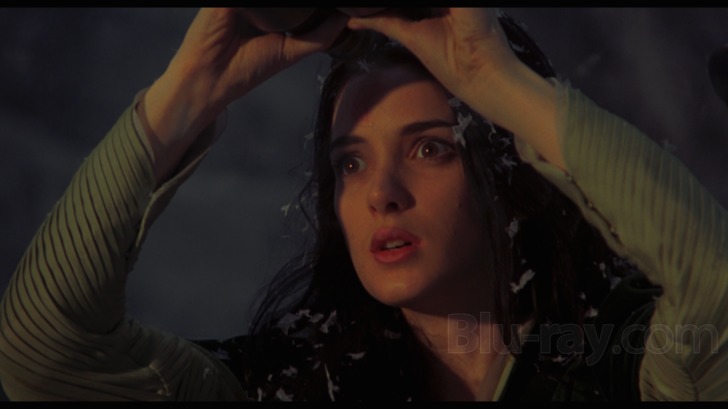
This review has been published in conjunction with the release of Sony's new 'Supreme Cinema Series' re-issue, a disc that significantly ups the
picture quality but comes with its own troublesome controversy. For comparative screenshots and additional thoughts, please click here.
Few eight-year-old discs have, and continue, to ignite so much debate and discussion as Bram Stoker's Dracula, a terrific film that seems a
bit
lost under the deluge of controversy surrounding its first foray onto the Blu-ray format. Criticized for off-kilter color timing and a less than stellar
general quality -- including hazy, fuzzy, sometimes borderline blurry details -- the transfer, at least in the online Blu-ray community, barely crossed
any
eyes that weren't in some way looking for problems, and found them rather easily. The image itself isn't horrible at-a-glance, but looking at it with
the benefit of hindsight, and in
comparison to the aforementioned "Supreme Cinema Series" reissue, its faults become only more clear. Details, even more than colors, are the
primary culprit here. This is a fairly flat transfer, lacking much nuance and absent the refined grain structure present on the new release. Both
broader shots and intimate object details alike find a greatly increased stability and exactness there that's lacking here. Details are frequently pasty
and flat, serviceable to be sure and not often horrific in good lighting, but lower light scenes struggle to find any real precision. Colors are a bit more
vibrant
and stable on the newer release, too. Dracula's red garb, for example, isn't exactly bland or flat here, but there's a noticeable bump in vibrance and
precision on the newer release that this one cannot match. Black levels here tend to favor a shade of blue, evident largely in nighttime exteriors;
darkened interiors don't appear quite so drastically altered, though the difference between more of a monochromatic push here to more subtle
variations of
blacks and grays in the newer release is clear. There's also more than a few minor speckles in this release that are gone on the newer, but nothing
too terribly bothersome or distracting. Certainly, the transfer
hasn't withstood the test of time (and didn't really stand up or apart on initial
release, either), and its flaws seem even more pronounced now that there's a newer, and in nearly every way vastly superior, release available for
comparison. Hopefully, this older release can now be retired and remembered more as a curiosity of a long-ago debate rather than a constant
reminder
of a great film presented in a less-than-desireable fashion on Blu-ray (though, certainly, the new release will be no stranger to controversy, either).
Bram Stoker's Dracula Blu-ray Movie, Audio Quality 
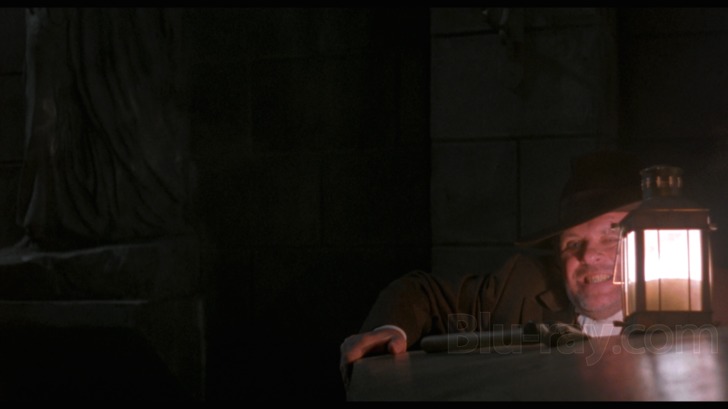
Sony's older soundtrack for Bram Stoker's Dracula isn't radically different from the newer release's Atmos/7.1 offering. This LPCM 5.1 track does lack the full-on richness and ability to deliver subtle, more immersive, more precisely placed atmospherics as well as bigger, more complexly detailed surround elements, but the core basics more than satisfy. While the newer track is also a hair sharper and louder when compared side-by-side at reference volume, this track delivers an even, well defined musical presence that's nicely spaced and accurate throughout the range. Haunting notes and support effects drift effortlessly around the stage, with a good bit of precision. The surrounds are filled with both light and heavy distinct elements in the film's most subtle moments in the castle and its most intense action scenes later in the film. A few gunshots aren't overly dynamic, but then again neither are they all that potent in the newer release. Both tracks share the ability to fully immerse the listener in the world with easy precision and definition; the sense of total richness and fullness is, however, a bit more apparent on the newer track. Dialogue, too, isn't radically different between releases, both yielding positive center-based placement and light reverberation when necessary.
Bram Stoker's Dracula Blu-ray Movie, Special Features and Extras 
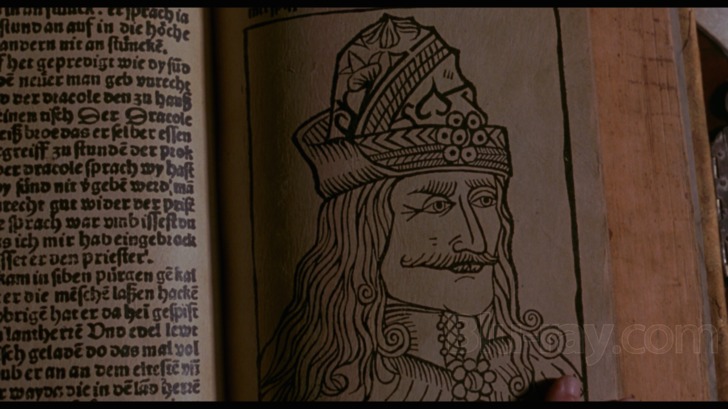
This release of Bram Stoker's Dracula, from early in the Blu-ray format's lifespan, contains many of the same extras found on the 2015
reissue. Beyond a couple of throwaway previews, there's nothing exclusive to this release.
- Audio Commentary: Director Francis Ford Coppola delivers another insightful, well spoken, and detailed track that covers the real history behind the story, technical construction, cast and performances, story and theme details, and much more. While some information repeats in both the other track and the other supplements, this is a quality listen that's well worth the time.
- Watch Bram Stoker's Dracula with Francis Coppola (1080p, 3:55): The director explores previous film adaptations of Dracula, the actors who have portrayed the character, his personal history and familiarity with the book, assembling his own filmed take on the story, and the film's title. This piece is intended to lead in to the commentary track.
- The Blood Is the Life: The Making of Bram Stoker's Dracula (1080p, 27:48): An examination of the film's more grounded and complicated portrayal of Dracula, remaining more faithful to the book than other Dracula-centric films, performances, core story themes and details, work on the set, and more, often intermixed with fascinating behind-the-scenes and raw on-set footage.
- The Costumes Are the Sets: The Design of Eiko Ishioka (1080p, 14:02): A detailed look at the importance of costumes in the film and their central role in defining the film's visual structure and style. Includes interviews with Francis Ford Coppola and Costume Designer Eiko Ishioka.
- In Camera: The Naïve Visual Effects of Dracula (1080p, 18:46): Roman Coppola explores the film's in-camera visual effects, including a brief history of visual effects, constructing the effects for this film, and the importance to the film that they remain in-camera and constructed in a fashion similar to how they may have been at the dawn of cinema in the late 1800s and early 1900s.
- Method and Madness: Visualizing Dracula (1080p, 12:06): Francis Ford Coppola, Roman Coppola, and Storyboard Artist Peter Ramsey go in-depth with the film's imagery and the inspirations for it.
- Deleted & Extended Scenes (480i): Prologue (6:28), Gypsies in Coach (1:08), Lucy's Party (3:44), Harker Meets Dracula (2:03), Harker/Dracula Dinner (1:04), Harker Explores Castle (1:44), Harker's Escape Attempt (4:14), Dracula on the Demeter (0:41), The Demeter Lands (0:58), Rule's Café/Convent (2:41), The Death of Renfield (1:41), and Ending (Early Version) (2:53).
- Bram Stoker's Dracula "Beware" Trailer (1080p, 1:28).
- Bram Stoker's Dracula Theatrical Trailer (1080p, 2:36).
- Trailers Theatrical Trailer (1080p). "Coming to Blu-ray" (1:13) and Ghost Rider (2:32).
Bram Stoker's Dracula Blu-ray Movie, Overall Score and Recommendation 
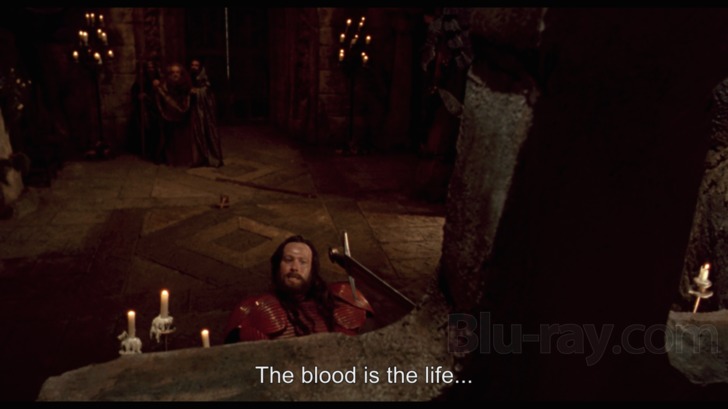
Bram Stoker's Dracula is one of this reviewer's favorite films, and for many reasons. It's widely approachable but intrinsically artistic, overt in story details but subtle in its depth and dramatic nuances, exciting yet grounded within its world, elegantly lavish in design, and very entertaining. The film tells a timeless tale of love and revenge, of good and evil, and does so with an elegance that's far too often missing in cinema. This older release of Bram Stoker's Dracula isn't unwatchable, but it pales compared to the new release. This older one might be worth keeping around as a curiosity, but the new release is a must-own. Owners of this disc who don't want to spend extra on fancy packaging can also pick up the film, with its new technical presentations, in a more budget friendly release that comes in a standard Blu-ray case. Newcomers are obviously encouraged to skip this and purchase one of the new releases, even if there's some question about the new transfer's framing.
Other editions
Bram Stoker's Dracula: Other Editions

Bram Stoker's Dracula
1992

Bram Stoker's Dracula
Supreme Cinema Series | Limited Edition
1992

Bram Stoker's Dracula 4K
25th Anniversary Edition
1992

Bram Stoker's Dracula 4K
30th Anniversary
1992
Similar titles
Similar titles you might also like

Byzantium
2012

The Wolfman 4K
Collector's Edition
2010

Dracula 3D
2012

Cat People 4K
Collector's Edition
1982

Interview with the Vampire
1994

Taste the Blood of Dracula
1970

Crimson Peak 4K
Standard Edition
2015

Penny Dreadful: The Complete Series
2014-2016

Hellraiser
1987

House of Dark Shadows
1970

Dracula
Includes "Drácula"
1931

The Invisible Man 4K
1933

Cursed
Collector's Edition
2005

Red Riding Hood
Alternate Cut
2011

True Blood: The Complete Series
2008-2014

Dracula: Prince of Darkness
Collector's Edition
1966

The Woman in Black
2012

Dracula's Daughter 4K
1936

The Phantom of the Opera
Collector's Edition
1962

The Satanic Rites of Dracula
Count Dracula and His Vampire Bride
1973